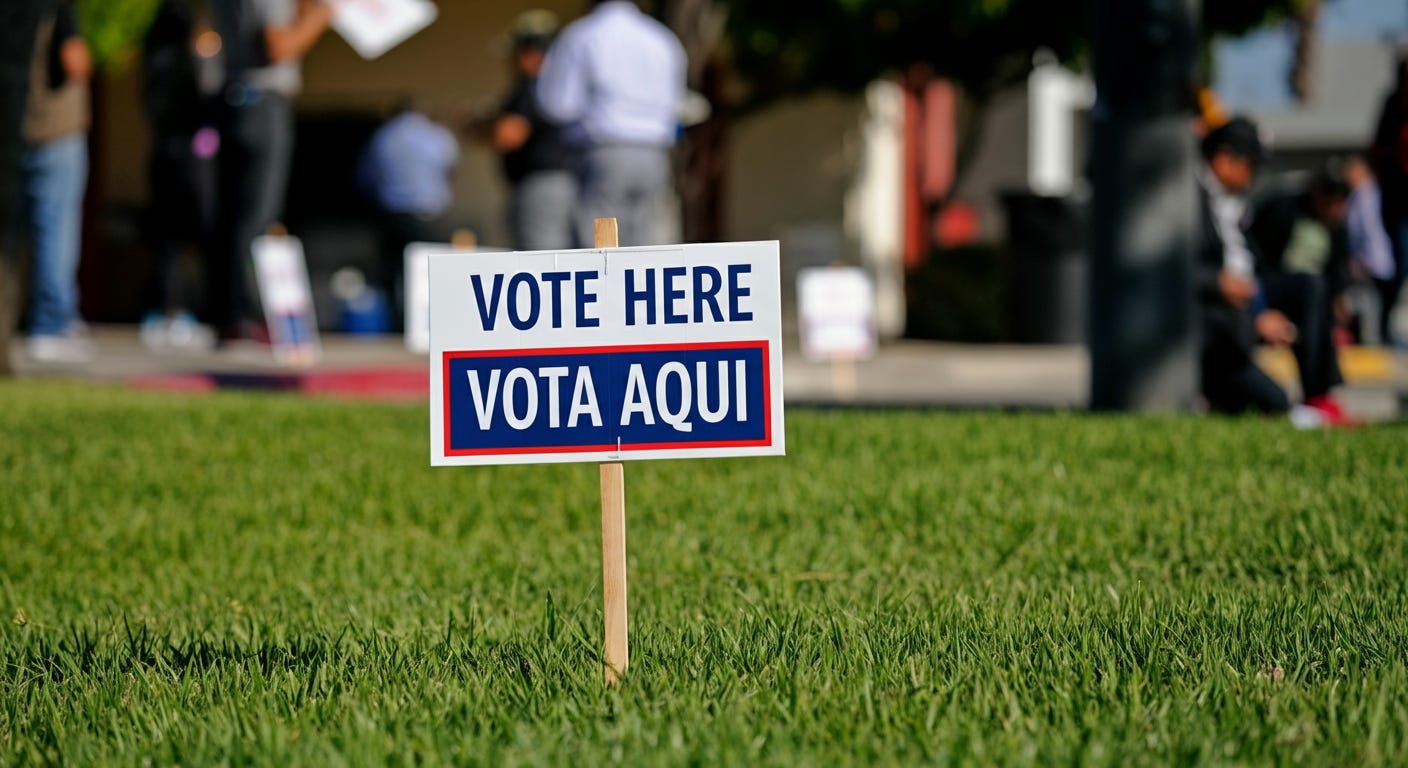The fight against election disinformation
How Spanish-language misinformation works and what public media can do
Tuesday is Election Day, and disinformation has emerged as a significant threat to democratic processes worldwide. As Latino USA this week and many outlets have remarked, Spanish-language misinformation is a major concern.
If this isn’t a topic you follow, I’ve got you. 🤞🏼
This OIGO explores what election disinformation targeting Spanish-speaking voters entails, with some examples and research findings. I also want to share how public media can actively meet this challenge. 💡
What is it?
Election disinformation refers to the deliberate dissemination of false or misleading information intended to deceive voters, suppress voter turnout, or manipulate public perception about candidates and election integrity. It crosses language, cultural and generational fault lines. From outright falsehoods (Photoshopped and AI-generated images; fabricated incidents) to misleading information (misrepresenting a candidate position based on a partisan bias), election misinformation is a wide-ranging threat.
In the United States, Spanish-speaking voters have become explicit targets of misleading campaigns. Why? For Spanish-dominant voters, a lack of information in one’s native language, a reliance on platforms with little moderation and few organizations making the electoral process accessible for Spanish-speaking residents contribute to this issue.
With attention on the power of the Latino vote and a tight race, it’s easy to see that misinformation can potentially influence electoral outcomes. 💣
Where you’ll see it
So, how exactly does Spanish-language election disinformation happen? When targeting Spanish-speaking voters, misinformation campaigns often leverage:
Systems awareness: If you don’t follow English-language news or know where to find verified information in Spanish, you might not know police are on site to protect poll workers, not check immigration status. Another example of misinformation that takes advantage of a lack of systems knowledge is misrepresenting voting days.
Exploiting cultural nuances: Tailoring messages that resonate culturally can make disinformation more persuasive. An example of this is a debunked video suggesting Vice President Kamala Harris was drunk in public, which might be seen negatively by those with particular views about alcohol, et al.
Using trusted channels: Utilizing platforms popular among Spanish speakers, such as social media, perpetrators of misinformation can quickly spread falsehoods. 🙈
There are also instances you may have seen covered in media.
Generative artificial intelligence been used to some effect among Spanish-dominant voters. In fact, a study by the Stanford Internet Observatory found an uptick in deepfakes targeting Hispanic audiences, complicating efforts to discern truth from fiction. The Brennan Center further explores combating politically oriented AI use.
What’s more, as Factchequeado reports, those turning to AI for elections help in Spanish are getting wrong answers.
Research by Tech Policy Press indicated that encrypted messaging apps like WhatsApp are exploited by bad actors circulating misleading messages about voting eligibility requirements. They know these platforms are harder to monitor and moderate. Similarly, the New York Times showed that some Spanish-language radio stations spread disinformation. However, a lack of station resources may be the cause for few fact-checking mechanisms. ☠️
Why does it matter?
The consequences of election disinformation directed at Spanish speakers are profound.
Misleading information about voting procedures can discourage or prevent individuals from casting their ballots. In addition, false narratives can undermine trust in public institutions. Finally, challenges in finding accurate information can lead to feelings of isolation, and effect Latinos’ perception of our value in the process.
How public media steps in
Public media organizations are positioned as few are to combat disinformation because of our commitment to public service, integrity and journalism. Here’s how your organization can make a difference:
Creating content that is culturally relevant and easily understandable is crucial. This includes simplifying complex electoral information, using multimedia formats, and informing audiences that it is available and curated by people.
Proactively monitoring social media and other communication channels for emerging disinformation trends allows public media to address false narratives before they spread widely. 🧿
Partnering with community leaders and local influencers can help disseminate accurate information effectively. These individuals often hold significant sway within communities.
Spanish-language fact-checking now until next week ensures that misinformation is identified and corrected promptly. Collaborations with organizations like Factchequeado can amplify these efforts.
Always remember
Election disinformation targeting Spanish-speaking voters threatens the integrity of elections. Public media has a critical role to play in combating this scourge. By expanding fact-checking efforts, engaging with communities, and producing accessible content, public media can help ensure that all voters have the information they need to participate fully. 🫱🏽🫲🏼
As we approach Election Day and beyond, the importance of public media’s efforts cannot be overstated. It is a collective responsibility to promote truth and transparency, ensuring that every voter, regardless of language or background, can make informed decisions. 🟢
Cafecito: stories to discuss ☕
Content. Local media picks up Ithaca Community Radio’s efforts to serve Spanish-speaking residents. 💬
Latino votes. WGBH spoke with Mike Madrid, who reflects on political parties’ appeal to Latino voters, and the long-term impact on American democracy. 🪫
Funding. The Chronicle of Philanthropy makes the case for supporting ethnic media in light of the current political climate. 💯
Growth. Speaking of, the Institute for Nonprofit News reports that support for BIPOC nonprofit media by funders is improving. 👩🏼🦰
Service. Wisconsin Watch spotlights a radio station aspiring to serve Latinos in the region. 📻
Felicidades. Ashley Alvarado is the new leader of Texas Public Radio. 🎉
El radar: try this 📡
Offer voter education in Spanish. Are you following New Hampshire Public Radio’s newsletter? There are some smart explainers in Spanish about voting, the candidates and the process that you can learn from. 🔦
KQED is among many outlets providing Spanish-language guides, and this one covers the region’s 500 races. 🔎
Learn how colleagues are engaging Latinx youth. Current reports on a New England Public Media training collaboration to bring young people’s perspectives into election coverage. 🗣️
Track ascendant Latine political power and potential tension. CalMatters reports on the 57th Assembly District in South Los Angeles, a historically Black area that is now predominantly Latino. This is a dialogue happening virtually everywhere. 🧮
Tell your audience how people run for office. Cicero Independiente hosted a Facebook Live panel that is unlike most everyone’s journalism. Panelists explained how someone runs for office, the complex rules and the experience into Election Day. 💻
Look into local Spanish-language radio. This CBS News conversation about the state of Latino radio might be an opportunity to speak with your own community partners about how they feel about local broadcasters. 🎤
The next OIGO arrives Nov. 15. I’m writing you from Seattle this morning, where I’ll be at KEXP’s Dia de los Muertos event, hosted by Albina Cabrera, tomorrow. I’d love to visit with you while there. 🪗
Join me Nov. 21 when Paige Robnett and I sit down for a conversation with Andrea G. Tatum on DEI Councils. 📲 Register here.
🥤 You can buy me a coffee if you’d like to support the newsletter.








